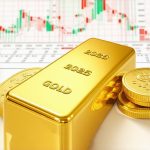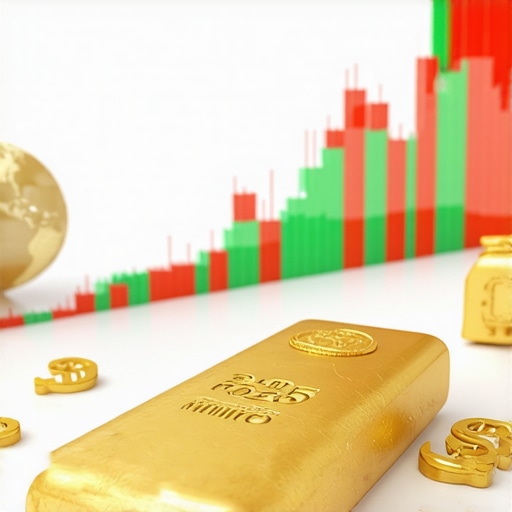Understanding Gold Demand Cycles: A Deep Dive into Market Drivers for 2025
The global gold market operates within a complex ecosystem where demand fluctuations are influenced by multifaceted economic, geopolitical, and technological factors. As experts analyze the 2025 outlook, it becomes clear that understanding these demand cycles is crucial for investors aiming to optimize their portfolios. This article explores the intricate demand drivers shaping gold prices and offers insights into how supply-demand dynamics will evolve in the coming year.
Key Factors Influencing Gold Demand in 2025
1. Geopolitical Tensions and Economic Uncertainty
One of the primary catalysts for increased gold demand remains geopolitical tensions, which often drive investors toward safe-haven assets. As international conflicts and trade disputes persist, demand for physical gold—such as coins and bars—tends to surge, reinforcing gold’s role as a hedge against volatility. According to a recent report by the World Gold Council, geopolitical instability significantly impacts gold’s demand in both retail and institutional sectors.
2. Central Bank Gold Purchases and Reserves Rebalancing
Central banks worldwide continue to adjust their gold reserves strategically. In 2025, fluctuations in central bank buying patterns, influenced by monetary policy shifts and reserve diversification efforts, will play a pivotal role. Notably, increased purchases by emerging market economies can propel prices upward, reflecting confidence in gold’s long-term value. For detailed analysis, see this comprehensive review.
3. Innovation in Gold-Backed Financial Instruments
The evolution of gold exchange-traded funds (ETFs) and digital gold platforms is transforming demand dynamics. Investors increasingly favor accessible, transparent mechanisms for gold exposure, which could amplify market liquidity and price discovery. The integration of blockchain technology with gold-backed assets suggests a future where demand is not only sustained but potentially expanded beyond traditional channels.
Expert Question: How Will Supply Constraints and Mining Trends Affect 2025 Gold Prices?
While demand surges are evident, supply-side factors such as mining output, geopolitical risk in gold-producing regions, and recycling rates are equally influential. Experts debate whether limited supply growth can meet rising demand, thereby creating upward pressure on prices. The supply-demand balance analysis underscores the importance of monitoring global mining trends and regulatory environments to anticipate future price movements.
For investors interested in diversifying within this context, exploring gold ETFs and mutual funds offers strategic options aligned with evolving demand patterns.
Ultimately, the trajectory of gold prices in 2025 hinges on a nuanced understanding of these demand and supply interplay, necessitating continuous market analysis and strategic agility.
To deepen your knowledge, consider consulting this expert outlook and engaging with specialized market analytics. Your insights and real-world experience can significantly contribute to refining demand forecasts and investment strategies in this dynamic market environment.
Deciphering Gold Supply Constraints: How Will Mining and Recycling Shape 2025 Prices?
As the global economy evolves, understanding the nuanced factors influencing gold supply becomes paramount for investors aiming to stay ahead. Central to this is the assessment of mining outputs, which are increasingly affected by geopolitical risks, environmental regulations, and technological advancements. For instance, disruptions in major gold-producing regions like South Africa and Russia can significantly tighten supply, amplifying upward price pressure. Additionally, recycling rates—comprising gold from electronic waste and jewelry—are adapting to shifts in global demand and technological innovation, offering a resilient alternative to mined gold. Experts argue that analyzing these supply-side elements offers a predictive edge in the volatile markets of 2025.
What are the implications of emerging technologies and environmental policies on gold supply sustainability in 2025?
Emerging technologies, such as automation and improved extraction methods, may enhance mining efficiency but can also face regulatory hurdles aimed at environmental protection. Countries imposing stricter mining restrictions or increasing taxation could limit supply growth, further complicating the supply-demand equation. Meanwhile, innovations in recycling—like advanced refining techniques—are expected to bolster secondary supply, yet their scalability remains uncertain amidst fluctuating demand. Investors should consider these evolving factors by consulting detailed market trend analyses to develop resilient investment strategies.
How Will Investor Behavior and Market Sentiment Drive Gold Prices in 2025?
Beyond tangible supply and demand metrics, investor psychology and market sentiment function as powerful catalysts in the gold market. During periods of economic uncertainty or currency devaluation, investors tend to flock towards gold as a safe haven, often resulting in rapid price escalations. Conversely, when confidence in traditional assets is restored, gold demand can wane, leading to price corrections. Additionally, the proliferation of digital gold and gold-backed financial products democratizes access, influencing market dynamics profoundly. According to a recent report by the World Gold Council, behavioral trends will continue to be a critical component in price movements, necessitating investors to stay attuned to geopolitical news and macroeconomic signals.
For strategic diversification, integrating gold ETFs and mutual funds can help manage exposure effectively, especially in turbulent times. Explore this comprehensive guide for more insights into portfolio optimization.
How Can Investors Leverage Market Trends to Maximize Gold’s Growth Potential in 2025?
Leveraging market insights requires a systematic approach—tracking gold price forecasts, demand-supply cycles, and macroeconomic indicators. Sophisticated tools like technical analysis, futures trading, and market sentiment tracking can significantly enhance decision-making. For example, understanding the impact of central bank purchases, as detailed here, can reveal strategic entry and exit points. Moreover, diversifying across physical gold, ETFs, and mining stocks helps balance risk and reward. Staying informed through expert analyses and real-time market data is essential for capitalizing on emerging trends and ensuring resilient growth in your gold portfolio.
Interested in expanding your knowledge? Consider exploring how long-term gold IRA strategies can serve as a foundation for sustainable wealth accumulation in 2025.
Emerging Technologies and Environmental Policies: Shaping Gold Supply Sustainability in 2025
As the global push towards sustainable development intensifies, the gold mining industry faces a paradoxical landscape of technological innovation and regulatory constraints. Advanced extraction techniques, such as automation and AI-driven resource management, promise to enhance efficiency and reduce environmental footprints. However, these technological strides are often met with stringent environmental policies aimed at safeguarding ecosystems and local communities. Countries like South Africa and Russia, major players in gold production, are increasingly implementing tighter regulations and higher taxation, which could hinder supply growth and tighten market availability.
Simultaneously, recycling of gold from electronic waste and jewelry has gained prominence as a vital secondary source. Innovations in refining processes, including hydrometallurgical methods, offer promising scalability, yet their widespread adoption hinges on economic viability and regulatory support. This delicate balance between technological progress and environmental stewardship will significantly influence the sustainability of gold supply in 2025, potentially leading to upward price pressures if supply constraints persist.
What are the implications of emerging technologies and environmental policies on gold supply sustainability in 2025?
Emerging technologies, such as automation and improved extraction methods, may enhance mining efficiency but can also face regulatory hurdles aimed at environmental protection. Countries imposing stricter mining restrictions or increasing taxation could limit supply growth, further complicating the supply-demand equation. Meanwhile, innovations in recycling—like advanced refining techniques—are expected to bolster secondary supply, yet their scalability remains uncertain amidst fluctuating demand. Investors should consider these evolving factors by consulting detailed market trend analyses to develop resilient investment strategies.
Deciphering Gold Price Sensitivity: How Will Market Sentiment and Macro Trends Interact in 2025?
Market sentiment, driven by geopolitical developments, macroeconomic policy shifts, and investor psychology, will continue to be a dominant force in gold price movements. During periods of heightened uncertainty—such as currency crises or geopolitical conflicts—demand for gold surges as a safe haven, often resulting in sharp price escalations. Conversely, periods of economic stability and confidence in fiat currencies may suppress demand, leading to corrections. The rise of digital gold platforms and gold-backed cryptocurrencies further democratizes access, amplifying behavioral influences on prices.
According to the World Gold Council, understanding these behavioral trends is crucial for making informed investment decisions. For example, tracking central bank gold purchases, as detailed here, can reveal strategic entry points and risk management opportunities.
How Can Investors Leverage Market Trends to Maximize Gold’s Growth Potential in 2025?
Leveraging market insights involves a multifaceted approach—combining technical analysis, macroeconomic indicator tracking, and sentiment analysis. Sophisticated tools like futures markets and options can help investors position themselves advantageously. For instance, understanding the impact of central bank purchases and geopolitical tensions can inform timing decisions. Diversification strategies, including physical gold, ETFs, and mining stocks, provide resilience against market volatility.
To deepen your understanding, explore resources like long-term gold IRA strategies, which serve as foundational elements for sustainable wealth accumulation in 2025.
Unraveling the Intricacies of Gold Price Volatility: A Strategic Perspective
In the ever-evolving landscape of the precious metals market, understanding the nuanced factors that influence gold prices in 2025 requires a multidimensional approach. Beyond traditional supply and demand metrics, recent advancements in market analytics and geopolitical intelligence have provided investors with sophisticated tools to anticipate price movements. Leveraging these insights can significantly enhance portfolio resilience and capitalize on emerging opportunities.
The Role of Macro-Financial Policies in Shaping Gold Demand
Macro-financial policies, including interest rate adjustments and currency interventions by major economies, exert profound influence over gold’s appeal as a hedge. For instance, unconventional monetary easing or tightening can alter investor perceptions of inflationary risks, thereby shifting gold demand patterns. Analyzing central bank policies in conjunction with global economic indicators enables investors to forecast potential price trajectories with greater precision.
How Do Geopolitical Developments Impact Gold Investment Strategies?
Geopolitical tensions, such as regional conflicts or trade disputes, often lead to surges in gold demand due to its safe-haven status. The recent escalation in geopolitical hotspots underscores the importance of real-time intelligence and scenario planning in investment decision-making. Incorporating geopolitical risk assessments into your strategy ensures preparedness against sudden market shifts, safeguarding assets during turbulent periods.
What Are the Emerging Technologies that Could Transform Gold Supply Chains?
Technological innovations, including blockchain-based traceability and automation in mining operations, are revolutionizing gold supply chains. These advancements promise increased transparency and efficiency, potentially reducing supply disruptions. However, regulatory adaptation remains critical; stricter environmental standards or new mining restrictions may offset technological gains, making continuous monitoring essential for informed investment decisions.
How Can Investors Harness Behavioral Economics to Optimize Gold Holdings?
Behavioral economics reveals that investor sentiment often amplifies market swings, especially during crises. Recognizing patterns such as herd behavior or overreaction enables strategic entry and exit points. Advanced sentiment analysis tools, coupled with macroeconomic data, can identify optimal moments to increase or reduce exposure, thus maximizing returns while managing risk effectively.
Where Should Experts Focus Their Analytical Efforts to Stay Ahead in 2025?
Expert analysts should prioritize integrating geopolitical intelligence, technological developments, and macroeconomic indicators within comprehensive modeling frameworks. Collaborations with data scientists and geopolitical strategists can enhance predictive accuracy. For authoritative insights, consult studies like the World Gold Council’s latest reports, which synthesize market data with geopolitical and technological trends, offering a holistic view of future market directions. Engage with these resources to refine your investment strategies and maintain a competitive edge in the dynamic gold market of 2025.
To further deepen your understanding and capitalize on emerging trends, explore specialized analysis platforms and consider consulting with industry experts who can provide tailored guidance based on real-time data and advanced predictive models.
Expert Insights & Advanced Considerations
1. Geopolitical stability remains a cornerstone for gold demand, yet emerging markets are increasingly influencing supply dynamics, making diversification essential for resilient portfolios.
With geopolitical tensions fluctuating, understanding regional risks and their impact on gold prices is vital. Emerging economies’ strategic gold acquisitions can signal long-term shifts in market power, emphasizing the need for investors to monitor geopolitical developments closely.
2. Technological advancements in mining and recycling are transforming supply chains, but regulatory and environmental hurdles could introduce new volatility levels.
Automation and AI in extraction processes improve efficiency, yet stricter environmental policies may restrict supply growth, fostering price pressures. Recycling innovations further diversify secondary supply, underscoring the importance of integrating supply-side insights into investment strategies.
3. Market sentiment, driven by macroeconomic policies and investor psychology, continues to be a dominant force, especially with digital gold platforms democratizing access.
Behavioral economics plays a crucial role, as herd behavior during crises can create rapid price swings. Investors should leverage sentiment analysis tools to anticipate and react to these shifts effectively.
Curated Expert Resources
- World Gold Council Reports: Comprehensive market insights and demand forecasts, essential for strategic planning.
- Bloomberg New Energy Finance: Data on technological innovations affecting mining efficiency and sustainability.
- International Monetary Fund (IMF): Analysis of macroeconomic policies influencing gold’s safe-haven appeal.
- Gold ETFs & Mutual Funds Analysis: In-depth reviews to optimize diversification and manage market risks.
- Geopolitical Risk Assessment Platforms: Real-time intelligence tools for proactive risk management.
Final Expert Perspective
In the evolving landscape of 2025, understanding gold demand cycles through the lens of geopolitical stability, technological innovation, and market psychology is paramount. The most successful investors will be those who synthesize these high-level insights, employing advanced analytical tools and strategic diversification. As the global economy navigates uncertainties, gold remains a vital component of resilient portfolios. Engage with authoritative sources and consider consulting with industry experts to refine your investment approach. Your proactive stance today can position you advantageously for the opportunities of tomorrow—because in the world of gold, foresight is your most valuable asset.










